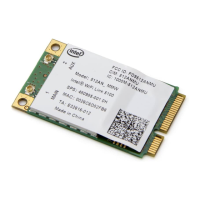as personal WEP, in that you can select Open network authentication and then click Enable 802.1X and be able
to choose from all client authentication types. The selection of authentication types are not available under
personal WEP.
Authentication Types
TLS
A type of authentication method using the Extensible Authentication Protocol (EAP) and a security protocol called
the Transport Layer Security (TLS). EAP-TLS uses certificates which use passwords. EAP-TLS authentication
supports dynamic WEP key management. The TLS protocol is intended to secure and authenticate communications
across a public network through data encryption. The TLS Handshake Protocol allows the server and client to
provide mutual authentication and to negotiate an encryption algorithm and cryptographic keys before data is
transmitted.
TTLS
These settings define the protocol and the credentials used to authenticate a user. In TTLS (Tunneled Transport
Layer Security), the client uses EAP-TLS to validate the server and create a TLS-encrypted channel between the
client and server. The client can use another authentication protocol. Typically, password-based protocols challenge
over a non-exposed TLS encrypted channel. TTLS implementations today support all methods defined by EAP, as
well as several older methods (
PAP, CHAP, MS-CHAP and MS-CHAP-V2). TTLS can easily be extended to work with
new protocols by defining new attributes to support new protocols.
PEAP
PEAP is a new Extensible Authentication Protocol (EAP) IEEE 802.1X authentication type designed to take
advantage of server-side EAP-Transport Layer Security (EAP-TLS) and to support various authentication methods,
including users' passwords, one-time passwords, and Generic Token Cards.
LEAP
A version of Extensible Authentication Protocol (EAP). Light Extensible Authentication Protocol (LEAP) is a
proprietary extensible authentication protocol developed by Cisco that provides a challenge-response authentication
mechanism and dynamic key assignment.
EAP-SIM
Extensible Authentication Protocol Method for GSM Subscriber Identity (EAP-SIM) is a mechanism for
authentication and session key distribution. It uses the Global System for Mobile Communications (GSM)
Subscriber Identity Module (SIM). EAP-SIM uses a dynamic session-based WEP key, which is derived from the
client adapter and RADIUS server, to encrypt data. EAP-SIM requires you to enter a user verification code, or PIN,
for communication with the Subscriber Identity Module (SIM) card. A SIM card is a special smart card that is used
by Global System for Mobile Communications (GSM) based digital cellular networks. RFC 4186 describes EAP-SIM.
EAP-AKA
EAP-AKA (Extensible Authentication Protocol Method for UMTS Authentication and Key Agreement) is an EAP
mechanism for authentication and session key distribution, using the Universal Mobile Telecommunications System
(UMTS) Subscriber Identity Module (USIM). The USIM card is a special smart card used with cellular networks to
validate a given user with the network.
Authentication Protocols
PAP
Password Authentication Protocol is a two-way handshake protocol designed for use with PPP. Password
Intel® PROSet/Wireless WiFi Connection Utility User's Guide

